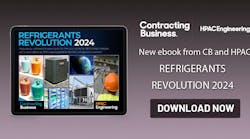In response to my Nov. 26 post, “Niche Products in the HVAC Industry,” I received several requests for information about the solar direct-expansion (DX) air conditioning I mentioned. I responded to as many of those requests as possible. Perhaps this will help readers who still have questions: First, this is not the same as using photovoltaic (PV) panels to power fans and controls or even an entire air-conditioning unit. That technology, represented by products such as Lennox SunSource, has been commercially available for several years, and SolarCity and Carrier recently announced they are teaming to provide PV to run high-efficiency air conditioning. The technology I addressed is different; it is solar thermal (much like a solar pool heater), not PV, and uses solar radiant energy to superheat an air-conditioning system’s refrigerant. The special evacuated-tube solar collectors are manufactured by Sedna Aire International in Homestead, Fla., and are available (at least for now) only for DX air conditioning.
In air-conditioning systems utilizing a vapor-expansion/compression (RVEC) cycle, the (generally) electric motor-driven compressor does most of the work—and, therefore, consumes most of the energy—because it mechanically adds pressure (and heat, as we will see below). This allows hot, high-pressure gas to condense and reject to the atmosphere heat it removed from supply air, with most of the condensation occurring in the bottom third of the condensing coil.
Remembering our basic thermodynamics, the ideal gas law states:
PV = nRT
where:
P = pressure of gas
V = volume of gas
n = amount (moles) of gas
R = universal gas constant
T = temperature of gas
So, if we hold the volume of gas constant and increase the temperature, the pressure will increase. And conversely, if we increase the pressure of gas, the temperature will increase. By flowing refrigerant through a solar collector, during periods of sunlight, the refrigerant will be superheated and utilize more of the coil (the upper two-thirds) for its change of state from vapor to liquid. With condensation occurring at a higher saturation pressure—and, therefore, higher ΔT (Tgas – Tamb)—there will be more condensed liquid available. There also will be more subcooling capacity, thereby removing load from the compressor and decreasing the electric energy consumed by the compressor motor.
In a test conducted here in Florida, a 5-ton Nordyne (all of the commercial equipment is now Trane) split system initially rated 15 SEER was installed in a government office. With the addition of solar superheating, the resulting seasonal energy-efficiency ratio was calculated by an independent engineer to be 31.5. In addition to improving efficiency, the additional volume of refrigerant required by the solar collector will increase the equipment’s effective capacity (British thermal units per hour). Doubling the efficiency of DX air conditioning would have been science fiction a few years ago. Today, it is just science.









